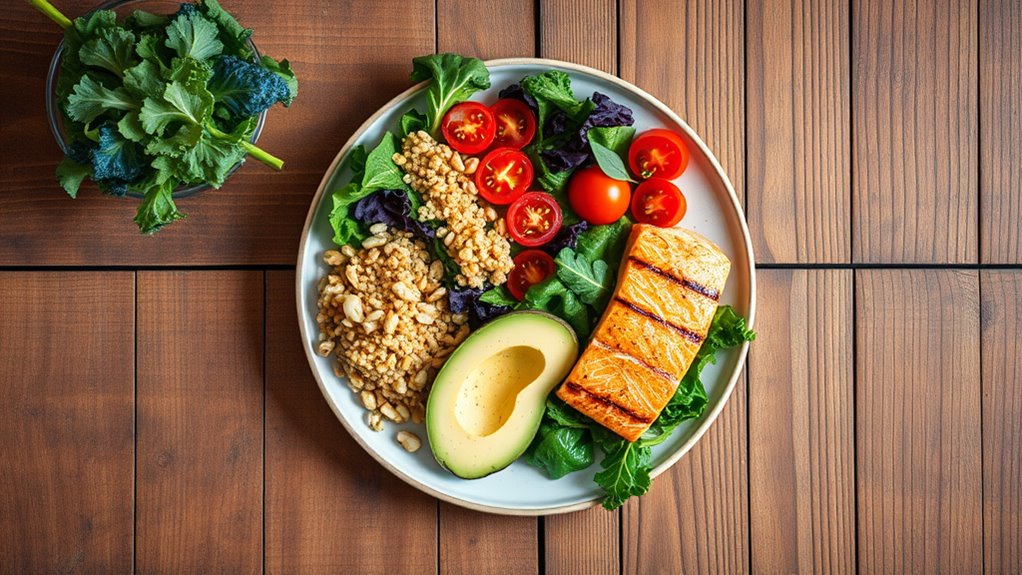How to Make Every Meal a Nutritional Powerhouse
Have you ever questioned whether you can truly turn every meal into a nutritional powerhouse? By selecting nutrient-dense whole foods like leafy greens and lean proteins, you’re building a solid foundation for better health. Now, consider how balancing macronutrients could amplify your energy, and we’ll uncover more strategies to optimize your daily intake.
Select Whole Foods for Nutrient Density
How can you select whole foods that maximize nutrient density?
In healthy meal planning, you prioritize nutrient-rich options like leafy greens, berries, and nuts, which provide abundant vitamins and minerals per calorie, as supported by dietary guidelines.
Opt for minimally processed choices, such as fresh vegetables and whole grains, to boost intake without added sugars or fats, ensuring every bite counts for peak health. Additionally, focusing on nutrient-dense foods can lead to improved health outcomes and sustained energy levels.
Balance Macronutrients in Every Dish
While macronutrients—proteins, carbohydrates, and fats—form the core of any meal, you balance them in every dish to support sustained energy and health.
To effectively balance, try this:
-
Prioritize proteins, like chicken or beans, for muscle repair and satiety, based on dietary guidelines.
-
Choose complex carbs, such as oats, for sustained glucose release, enhancing focus and energy.
-
Incorporate healthy fats, like from nuts, to boost hormone function and nutrient uptake.
Additionally, consider including essential nutrients like magnesium and omega-3 fatty acids, which are often overlooked yet critical for overall health.
Incorporate Colorful Vegetables and Fruits
You select a variety of vibrant vegetables and fruits to boost your meals’ nutrient density with essential vitamins and antioxidants. You blend these colorful options into your dishes, such as smoothies or stir-fries, to enhance flavor and texture without overpowering other ingredients. This strategy helps you achieve a balanced, health-promoting diet that supports overall well-being. Additionally, incorporating superfoods like essential vitamins can further enhance the nutritional value of your meals.
Select Vibrant Produce
When choosing vibrant produce, focus on a variety of colorful vegetables and fruits to maximize nutrient density; for instance, red options like tomatoes offer lycopene for heart health, while greens such as spinach provide iron and folate.
To select the best, you’ll want to:
- Examine colors for vibrancy, indicating higher nutrient levels.
- Feel for firmness; it guarantees freshness and ideal vitamins.
- Smell for a fresh aroma, confirming ripeness and quality.
Blend Into Dishes
Once you’ve selected vibrant produce, integrate it into dishes to amplify nutrient intake and flavor profiles.
You can blend leafy greens into smoothies for a nutrient surge, mix berries into yogurts for antioxidants, or stir chopped peppers into stir-fries for vitamins.
This method boosts dietary diversity, as research shows colorful additions enhance gut health and reduce inflammation, making meals both practical and delicious.
Practice Mindful Eating for Better Digestion
You slow down eating to allow your body time to signal fullness, reducing overeating and aiding digestion.
You chew food thoroughly to break it down into smaller particles, making it easier for your stomach to process and absorb nutrients.
You eat without distractions to stay attuned to your body’s hunger signals, which promotes better portion control and gastrointestinal health.
Incorporating mindful eating techniques can also help you develop a more positive relationship with food.
Slow Down Eating
How does slowing down your eating enhance digestion? It gives your body time to release enzymes effectively, signaling fullness and reducing bloating.
-
Put your fork down between bites to naturally extend meal duration.
-
Eat in a calm, distraction-free environment to focus on the process.
-
Set a timer for meals to last at least 20 minutes, as studies show.
This practice improves nutrient absorption and prevents digestive issues.
Chew Food Thoroughly
Thoroughly chewing your food breaks it down into smaller particles, kickstarting digestion before it even reaches your stomach. This boosts nutrient absorption and reduces overeating, as research links it to better enzyme activation and satiety signals. You’re improving oral health and gut function by chewing 20-30 times per bite.
| Benefit of Chewing Thoroughly | Practical Action |
|---|---|
| Enhances digestion | Chew each bite slowly |
| Aids weight control | Focus on texture fully |
| Supports oral health | Avoid gulping food |
Eat Without Distractions
Eating without distractions transforms mealtime into a mindful practice that boosts digestion by fostering full awareness of each bite.
Research shows this reduces overeating and improves gut function.
To practice effectively:
- Turn off screens to focus fully on your meal, enhancing enjoyment and digestion.
- Sit in a calm space, engaging your senses to notice flavors and textures.
- Eat slowly, paying attention to hunger cues for better nutrient absorption.
Add Healthy Fats and Proteins Strategically
As research shows, these nutrients stabilize blood sugar and enhance nutrient absorption. Opt for avocados and nuts for fats, and lean meats or legumes for proteins; studies confirm this pairing improves heart health and aids weight management by curbing cravings effectively. Additionally, incorporating specific foods like omega-3 fatty acids can further enhance cognitive function and mental clarity, supporting overall brain health.
Optimize Meals for Daily Energy and Health
To optimize your meals for daily energy and health, focus on balancing macronutrients that sustain your body’s functions without spikes or crashes.
This approach draws from nutrition science to enhance vigor:
-
Incorporate complex carbs like oats; they’ll provide steady glucose for brain fuel.
-
Add lean proteins such as chicken; it maintains muscle and curbs hunger.
-
Include healthy fats from avocados; they’re essential for hormone balance and absorption.
Additionally, incorporating anti-inflammatory foods like turmeric and berries can further support your body’s health and reduce inflammation.


